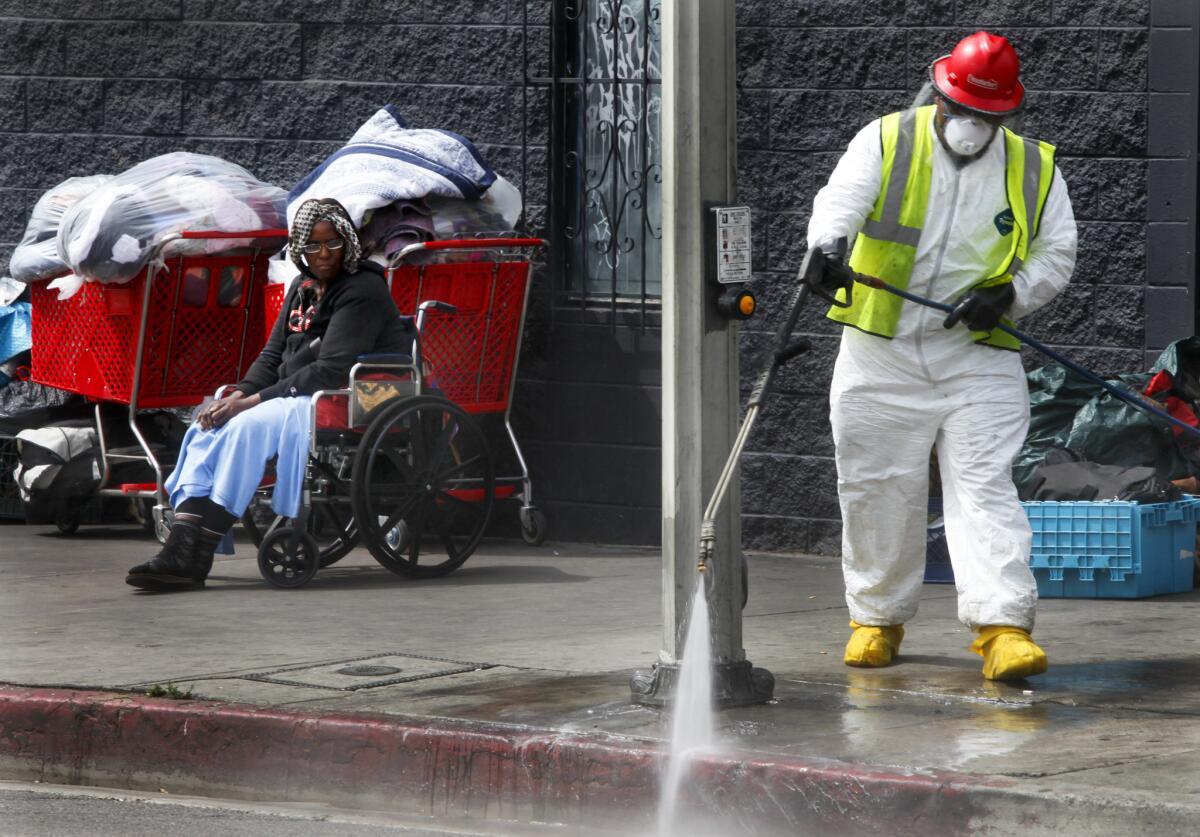L.A. moves closer to easing limits on seizing homeless people’s belongings

A homeless woman named Patricia watches from her wheelchair near the corner of 6th Street and Gladys Avenue while a sanitation worker uses a pressure washer to clean the streets of skid row.
- Share via
The city of Los Angeles moved closer Monday to making it easier to remove homeless people’s belongings from public parks, over opposition from City Councilman Gil Cedillo, who said it was a failed strategy.
“We have pursued a strategy that does not work,” Cedillo told the arts, parks, health, aging and river committee, which voted 4 to 1 to approve the new ordinance. “The overemphasis on policing is a fetter.”
In 2012, a federal appeals court ruled the city could seize and destroy transients’ possessions only if they posed an immediate threat to public health or were evidence of a crime. The court also required the city to give owners a chance to reclaim their belongings before they are destroyed.
Faced with an 85% rise in encampments in the past two years, the city has been looking for ways to clean up skid row and other concentrations of homeless people without running afoul of the courts.
The new ordinance would shorten from three days to 24 hours the city’s advance notice of a confiscation from parks, including Venice Beach. It would also clarify that bulky items -- including mattresses, chairs or other furniture -- can be subject to immediate removal. It also would bar putting up tents on park property, although shade structures, and picnic tables and chairs would be exempt.
Violations could be charged as an infraction or misdemeanor.
A companion proposal to make it easier to move homeless people’s possessions off sidewalks is making its way through the City Council’s committee process. Under a separate court settlement, homeless people are allowed to sleep on city streets overnight, but are supposed to carry or store their tents and bedrolls during daylight hours.
City Councilman Joe Buscaino said the parks ordinance struck the “proper balance” between homeless people’s constitutional rights and the public’s right to clean and safe parks.
“We have seen these public spaces completely thrashed ... by tents and tarps that come with, unfortunately, feces and urine,” Buscaino said.
Advocates accused the city of criminalizing homeless people.
“The people cannot help this; they have nowhere else to put their possessions,” said Deborah LaShever, a Venice resident and activist.
Kevin Regan, assistant general manager of the Department of Recreation and Parks, said the city would continue to store homeless people’s possessions at a skid row warehouse for 90 days.
Several speakers said, however, that the storage building is at capacity, and that homeless people don’t understand where their belongings are or how to recover them.
“We have a notification problem,” said General Jeff Page, a skid row activist. “This is about seizure.”
“It’s unfair for [homeless people from] San Pedro to have to come to L.A. It’s unfair for the San Fernando Valley to come to L.A.,” Cedillo said. “It’s designed that way.”
Regan said two park rangers are assigned fulltime to handle complaints about homeless people’s possessions on park land, which have included reports of needles in sandboxes and of homeless people refusing to take tents down from a Little League field. He also said employees team with outreach workers to offer homeless people services.
“The bottom line is this is an effort to keep the parks clean and accessible for the public,” Regan said. City employees, he added, “deal with this in a very compassionate way.”
“This gives us a tool for getting them out faster,” said Valerie Flores, senior assistant city attorney.
Cedillo said the city doesn’t need a new ordinance to remove encampments on ballfields and needles from playgrounds.
“I support the broken window theory,” said Cedillo, referring to a skid row cleanup strategy introduced by former Police Chief William Bratton that cracked down on minor infractions by homeless people. “But it doesn’t work if there isn’t a house.”
Follow @geholland for news about homelessness.
More to Read
Sign up for Essential California
The most important California stories and recommendations in your inbox every morning.
You may occasionally receive promotional content from the Los Angeles Times.














